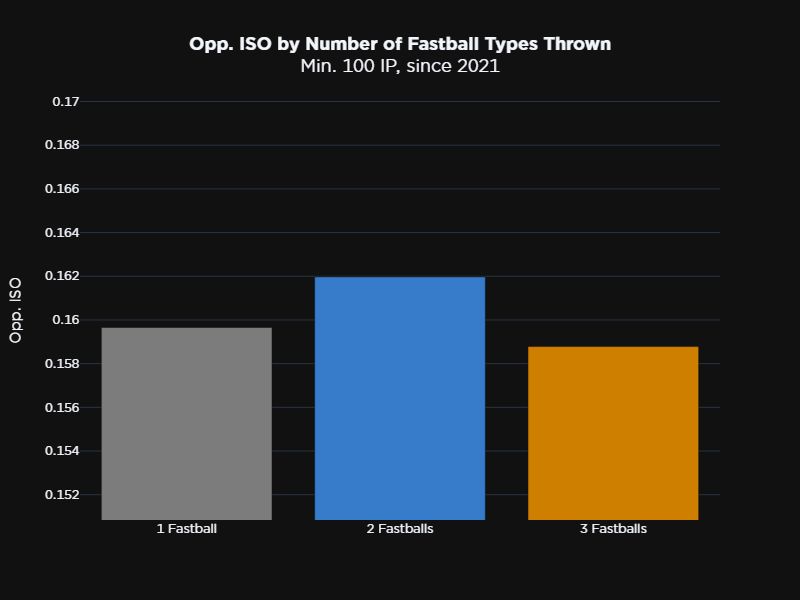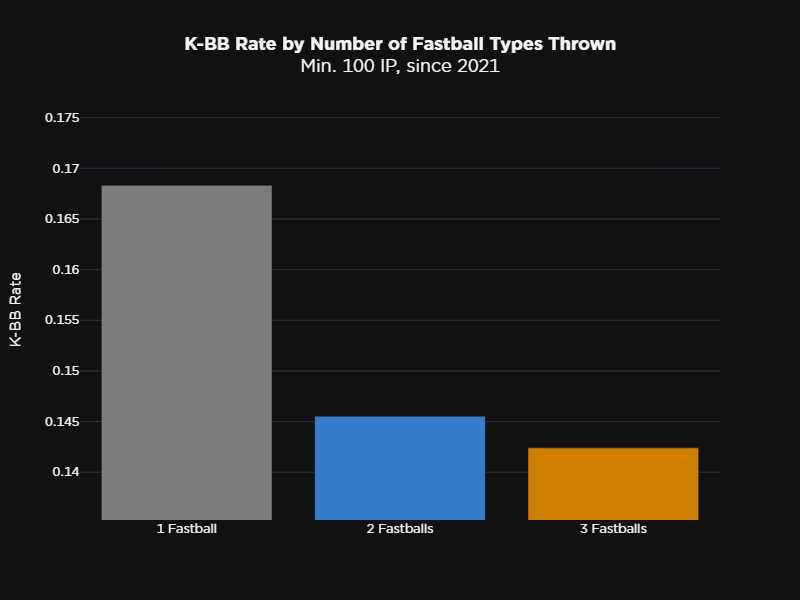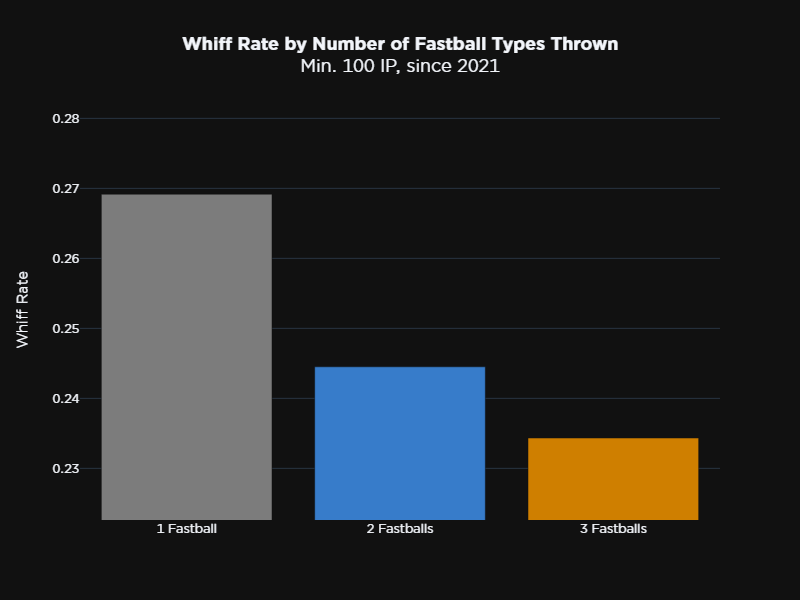How many fastballs should a pitcher have on the menu?

Logan Webb did a curious thing in 2025, well, a few curious things.
San Francisco Giants ace had alrady long established himself as one of the better starters in the game. He’s long been a durable, innings-eating, groundball-producing machine.
But in 2025 he offered something new: he began striking out batters.
He eclipsed 200 Ks for the first time in a season (224), and posted the top full season strikeout rate of his career. His strikeout percentage gain marked the second greatest year-over-year improvement in MLB. Striking out more batters helped Webb to his best fWAR, FIP, and xFIP marks, and the second-best expected ERA of his career.
What’s interesting about his campaign is he accomplished without throwing any harder in 2025. Moreover, his overall Stuff+ score declined to the lowest levels of his career. His excellent command remained steady.
What changed? He started throwing more pitches – a specific type of arsenal expansion.
Webb is not a pitcher who struggles to create movement. He’s one of the first arms to attempt, and succeed, in harnessing seam-shifted wake since its become understood in modern pitch-design era. There are many GIFs of his east-and-west darting sinkers, changeups and sweepers.
But he had voids in his pitch plot.
Hitters could eliminate worrying about north and south and more neutral pitch types and location.
What did he do?
He expanded his pitch menu to make the calculus more difficult, forcing hitters to defend a greater array of potential options and locations. And he did it not by adding designer breaking balls but rather with fastballs.
He added a cutter in 2024 and increased its usage in 2025. Once a four-seam dominant pitcher, it was an offering he had largelyy shelved since his reinvention as a two-seam artist. Yet, in 2025 he threw at his four-seamer at the most frequent rate since 2021 (7.8% rate). After sprinkling in a new cutter in 2024, he also ramped that up to a career-best rate in 2025 (2.6% to 7.9%).
While his raw stuff declined, his overall results improved.
Among qualified pitchers, Webb enjoyed the second greatest decline in out-of-zone contact in the majors in 2025 (-10.8%), one of only two pitchers to enjoy double-digit declines with Cristopher Sanchez being the other. He also enjoyed the ninth greatest decline with zone contact (-1.4%).
Over 207 innings in 2025, a large single-season sample in the modern era, Webb proved there is tremendous benefit – at least for some arms – in expanding an arsenal even when it reduces the overall Stuff+ grade of an arsenal.
“It is almost like trying to get a hitter off your scent,” Driveline’s Arizona pitching coordinator Dylan Gargas said.
Michael Wacha is another veteran pitcher who added a new fastball to become a three-fastball arm like Webb.
Wacha began his career with a four-seam and changeup combination, an unusual pairing for a successful right-handed starter. But those offerings were so good for the first full four seasons of his career the unusual mix didn’t matter.
“I’m a pronator so I’ve always had trouble spinning the ball,” Wacha told me in September.
While Wacha always possessed a cutter he mixed in sparingly, he needed other offerings to better combat his reverse platoon splits as his career began to sputter in 2018-21.
In 2022 with Boston, he began throwing a two-seamer at a double-digit rate which he’s continued since. And when joining the Royals as a free agent in 2024, he also added a slider.
Even though these added offerings don’t grade as plus offerings, even though he’s a natural pronator, these different looks have allowed him to level his platoon splits. His best two seasons by fWAR have come in the last two years. Wacha said it was modern pitch design that helped him add those pitches and dip into the pro-supinator bucket of offerings.
“That’s where I use the tech,” Wacha said. “’Are my fingers getting to the front of the ball?’ It could have helped out earlier but I’ve tried to take advantage of it now.”
While Wacha and Webb have other pitches, too, they are two pitchers who have evolved to throw three fastballs.
They are not alone.
Consider that in 2015 there were 263 MLB starting pitchers that threw at least 10 innings. Within that group, 52 threw three fastballs at a rate or 5% of more
This past season in 2025 there were 253 starting pitchers who tossed at least 10 innings, and of that sample 92 threw at least three fastballs at a rate of 5% or greater.
“You hear about guys getting bucketed with the pronation, and supination biases, I think they’ve often been convinced that they can only do one or the other,” Gargas said. “So, there’s been a shift there, a belief, just the knowledge being able to throw multiple (fastballs).”
More pitchers are throwing more fastballs and getting away from the idea they can only reside in the two- or four-seam bucket.
Whether you are a natural pronator or supinator, there is evidence that not all fastball shapes have to grade as plus pitches to be effective in raising the performance of an overall arsenal.
This made me curious.
How many pitchers should be adding pitches? It’s an especially relevant question in this age of pitch design – when technological advancements and an avalanche of data have never made it easier to add a new pitch.
While we can isolate and evaluate an individual pitch relative to a league average, it’s more difficult to evaluate how expanding an arsenal influences overall performance.
I asked Driveline’s Jack Lambert to bucket MLB starting pitchers (minimum 100 innings) by one-, two-, and three-fastball arsenals to see what we could glean from a macro-level regarding the benefits of throwing more – or fewer – fastballs.
What we found was interesting.
Pitchers who threw three fastballs had the lowest walk rates among all groups.

They also enjoyed the lowest isolated slugging percentage allowed to opponents followed by one-fastball hurlers.

Pitchers that threw just one fastball enjoyed the best FIP- performance with a gap to the three-fastball group followed by the two-fastball contingent.
The one-fastball crowd also enjoyed a slight edge in ERA over the three-fastball cohort.
But then the one-fastball group started to gain a greater edge.
The K-BB metric was dominated by the one-fastball group as was the strikeout percentage, and the one-fastball group also led in WHIP (followed by the three fastball crowd).

The one-fastball bucket also had a massive edge in whiff rate.

Overall, the one-fastball cohort performed best, which suggests those pitchers often possess a dominant fastball pitch they can lean on, Lambert noted. A pitch like Bryan Woo’s four-seamer is still difficult to handle even if an opponent is anticipating it.
But if a pitcher does not possess an elite fastball, it can make sense to add a platoon-neutral offering (cutter) in addition to possessing both a four-seamer and sinker to combat opposite- and same-sided batters.
There is another benefit in adding fastballs, Gargas noted.
“Typically, fastball or fastball variations are just going to be easier for someone to get in their hand and locate relatively well compared a big new breaking ball or changeup,” Gargas said. “It makes sense as to why that trend (adding fastballs) is a bit more popular just because those should be easier to adapt from a pitch-design standpoint. You see all these guys where the running joke is all the (breaking ball) shapes are there but they miss their spot by three feet. It’s an uncompetitive pitch. But if they look at the actual metrics of the pitch, it looks really good. It’s just a matter of like ‘Man, if they could just throw that over the plate.’
“With the fastball variations … It’s pretty easy to plug and play.”
Ultimately, the decision should be individualized and it begins with a question.
If a pitcher has an issue versus same-sided or opposite-handed batters, they ought to consider expanding an arsenal with another fastball (or two). If a pitcher enjoys a dominant fastball, they don’t need to worry about diluting their pitch mix.
In other words, a pitcher shouldn’t complicate a fastball mix if he enjoys a great offering. But for more pitchers, there is a benefit in adding more fastballs to their menu of options.
Comment section